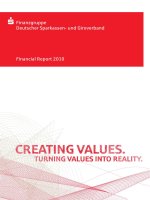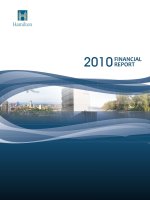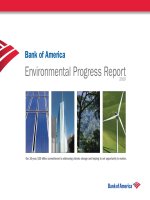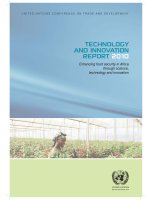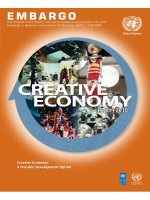Annual Mekong Flood Report 2010
Bạn đang xem bản rút gọn của tài liệu. Xem và tải ngay bản đầy đủ của tài liệu tại đây (4.55 MB, 79 trang )
Flood Management and Mitigation Programme
Mekong River Commission
Annual Mekong Flood
Report 2010
Cambodia
.
Lao PDR
.
Thailand
.
Viet nam
For sustainable development
ISSN: 1728-3248
Mekong River Commission
Annual Mekong Flood Report 2010
July 2011
Page ii
Published in July 2011 by the Mekong River Commission
Cite this document as:
MRC (2011) Annual Mekong Flood Report 2010, Mekong River Commission, 76 pages.
The opinions and interpretation expressed within are those of the authors and do not
necessarily reflect the views of the Mekong River Commission.
Graphic design editor: S. Cheap
Contribution author: P.T. Adamson, S. Hak, S. Pathoummady, B. Buasuwan, M.T. Vu
Page iii
Table of contents
Acknowledgements xi
1. Synopsis and Content 1
2. Aspects of the Climate of the Mekong Basin and its Relationship with the Flood
Report 3
2.1 Context 3
2.2 The Flood Concept in Large Tropic Monsoonal Rivers 4
2.3 The Asian Monsoon over the Last Millenium 6
2.4 The Regional Rainfall Climate – Geography and Seasonality 14
2.5 Regional Rainfall Extremes 17
3. The 2010 Flood Season 21
3.1 Overview 21
3.2 Rainfall and Soil Moisture 22
3.3 Stream Flow and Water Levels during the Flood Season of 2010 32
3.4 The Continuing Impact of the Dams in China on Mainstream Hydrology 42
4. Cambodia 2010 Country Report 45
4.1 General Situation 45
4.2 October Flash Floods and Urban Flooding 45
4.3 Lessons Learned 46
5. Lao PDR 2010 Country Report 49
5.1 General Situation and Localised Flash Flooding 49
5.2 Flash Flood Damages 50
5.3 Lessons Learned 51
6. Thailand 2010 Country Report 53
6.1 General Situation 53
6.2 Rainfall 53
6.3 The Events of August and October 54
6.4 Overall Damage, Lessons and Recommendations 56
7. Viet Nam 2010 Country Report 57
7.1 General Situation 57
7.2 Rainfall 57
Page iv
7.3 Water Levels 57
7.4 Damages 58
7.5 Recommendations 59
8. Summary Conclusions and recommendations 61
References 63
Page v
Table of figures
Figure 1: Regional context and places referred to in the text xiii
Figure 2. 1: Frequency histogrammes of the historical distribution of the annual flood
volumes on the Mekong at Kratie which are normally distributed. The annual
flood volumes are classified as ‘significantly’ and ‘extremely’ above or
below their normal range. A significant year corresponds to a flood with a
recurrence interval exceeding 1:10 years (10% annual probability) and an
extreme year to a flood with a recurrence interval exceeding 1:20 years (5%
annual probability) 4
Figure 2. 2: Pinus Krempfii tree ring chronology from the Central Highlands of Viet Nam
(1660 to 2003) 7
Figure 2. 3: A 1000 year reconstruction of the PDSI for Southern Viet Nam, indicating
multi decadal periods of flood and drought (based on a specimen of Pinus
Krempfii in the Central Highlands, the data kindly made available by the
University of Columbia, NY). 8
Figure 2. 4: The Angkor droughts of the 14
th
and 15
th
Centuries observed in a tree ring
chronology (species Fokienia hodginsii) from Southern Viet Nam. These
droughts were an additional ‘stressor’ at a time when the civilization was
already in decline. (Source: Buckley et al, 2010) 9
Figure 2. 5: The components of the Asian Monsoon and the regional tree ring network
from 327 sites, along with the grid onto which the annual summer monsoon
PDSI values were projected. (Source: Cook et al, 2010) 10
Figure 2. 6: Spatial drought patterns during four well documented historical Asian
droughts. The Ming Dynasty Drought (1638 to 1641), the Strange Parallels
Drought (1756 to 1768), the East India Drought (1792 to 1796) and the Great
Victorian Drought (1876 to 1878). (Source: Cook et al, 2010) 11
Figure 2. 7: The strong El Niños during the Great Victorian Drought (A) and the Indo
China Drought of 1918 – 1919 (B). (Source: Cook et al, 2010) 12
Figure 2. 8: This plot shows the joint sample distribution of the annual flood season
volume and peak at Kratie (1924 to 2010). Although strong El Niños and La
Niñas have historically brought extreme drought and flood conditions
respectively to the Mekong, the relationship is not generally coherent for
ENSO conditions as the result shows. If it was the ‘red dots’ would be
concentrated in the lower left hand quadrant and the ‘blue dots’ concentrated
in the upper right hand quadrant 13
Figure 2. 9: The geography of the mean annual rainfall climate in the Lower Mekong
Basin. 15
Figure 2. 10: The monthly and annual distribution of rainfall at three locations
representative of the north, central and southern parts of the Lower Mekong
Basin. 16
Figure 2. 11: One in two year comparative storm intensities for durations of 60 minutes
and less, indicative of Mediterranean, temperate and tropical monsoonal
climates (based in part on data in Maksimović et al, 1993). 18
Page vi
Figure 2. 12: One in two year comparative annual maximum storm rainfall depths for
durations of 1 to 3 days for two representative sites in the Lower Mekong
Basin and two in Australasia. The Mekong data indicate a greater persistence
of extreme rainfall over these longer durations, indicated by the much greater
relative increase between1 and 3 day totals (based in part on data in Daniell
and Tabios, 2008) 18
Figure 2. 13: The same data as those in Figure 2.13 with the addition of those for Baguio
City in the Philippines which has one of the most globally extreme storm
rainfall climates due to the high annual incidence of typhoons (based in part
on data in Daniell and Tabios, 2008) 19
Figure 2. 14: Vientiane (1951 – 2006) – percentage of wet days on which more than 25 and
50 mm were observed 20
Figure 3. 1: Cumulative daily rainfall at Vientiane and at Pakse during 2010 compared to
the long term pattern. At Vientiane the 2010 SW Monsoon began at the end
of May but rainfall until late July was considerably below normal. Only
during August and September did rainfall accumulate in any significant
amounts, such that the final total for the year as a whole was close to average.
At Pakse the whole Monsoon season saw rainfall at critically low levels - as
much as 800 mm below normal at the end of August 23
Figure 3. 2: Rainfall over the Lower Mekong Basin – June 2010 25
Figure 3. 3: Rainfall over the Lower Mekong Basin – July 2010 26
Figure 3. 4: Rainfall over the Lower Mekong Basin – August 2010 27
Figure 3. 5: Rainfall over the Lower Mekong Basin – September 2010 28
Figure 3. 6: Rainfall over the Lower Mekong Basin – October 2010. 29
Figure 3. 7: The long term average value of the ‘Normalised Difference Vegetation
Index” (NDVI) for the 4
th
week of August. High values (green) indicate that
crops and natural vegetation are under no ‘stress’ since there is sufficient soil
moisture. Low values (red) indicate vegetative stress due to critically low
levels of soil moisture. (Source: http:\\earthobservatorynasa.gov ) 30
Figure 3. 8: The value of the ‘Normalised Difference Vegetation Index” (NDVI) for the
4
th
week of August in 2010. Compared to the expected values as indicated in
Figure 3.6 large areas of the Basin show crops and vegetation under high
levels of moisture stress, most notably in southern Lao PDR and northern
Cambodia. (Source: http:\\earthobservatorynasa.gov ) 31
Figure 3. 9: The definition of the flood season, with the mean annual hydrograph at
Kratie as the example. The onset is the date of the up-crossing of the long
term mean annual discharge (or water level) and the end, the down-crossing.
In a typical year, there is only one such crossing in each case 32
Figure 3. 10: The 2010 annual hydrographs at Chiang Saen and at Vientiane / Nong Khai,
compared to their long term average 35
Figure 3. 11: The 2010 annual hydrograph at Pakse and at Kratie, compared to the long
term average. 36
Figure 3. 12: The 2010 annual hydrograph at Prek Dam, Phnom Penh Port and at Chao
Doc, compared to the long term average 37
Figure 3. 13: Scatterplots of the joint distribution of the annual maximum flood discharge
(cumecs) and the volume of the annual flood hydrograph (km
3
) at selected
sites on the Mekong mainstream. The ‘boxes’ indicate one ( 1δ ) and two ( 2δ
Page vii
) standard deviations for each variable above and below their respective
means. Events outside of the 1δ box might be defined as significant flood
years and those outside of the 2δ box as historically extreme flood years. 38
Figure 3. 14: Mekong at Kratie - the bi-variate distribution of annual flood peak and
volume, 1924 to 2010. Four other events comparable to that of 2010 in terms
of the joint magnitude of the two variables have previously been observed.
The estimated recurrence interval of the 2010 deficient annual flood
conditions lies between once in ten and once in twenty years 39
Figure 3. 15: Mekong at Kratie - the 1992 and 2010 annual hydrographs compared. In
terms of their peak and volume the two years are quite similar. The
distinction lies with the onset and end of the flood season which was a month
earlier and 10 days earlier respectively in 1992 compared to 2010 40
Figure 3. 16: Mekong at Kratie – modular annual flood volumes and maximum flood
discharges as % deviation above the long term means (1924 to 2010) 41
Figure 3. 17: Chiang Saen: the 2009 daily discharge hydrograph compared to the long term
average showing the high frequency day to day fluctuations which continued
into 2010. 42
Figure 3. 18: The annual number of discharge reversals at Chiang Saen, Luang Prabang
and Vientiane, 1960 – 2010 43
Figure 5. 1: Provinces of Lao PDR affected by flash flooding during 2010 49
Figure 6. 1: Thailand – monthly rainfall: August, September and October, 2010 (Source:
Thai Meteorology Department). 53
Figure 6. 2: The extent of flood inundation in the Mun – Chi Basin during October 54
Figure 6. 3: Flood affected provinces in Thailand – 2010. 55
Page viii
List of tables
Table 2. 1: Average annual proportion of wet days at selected sites in the Lower Mekong
Basin upon which >25mm and >50mm of rainfall occurs. These figures may be
compared to those typical of temperate rainfall climates, here represented by the
data for London 17
Table 2. 2: Estimated annual maximum ‘n-day’ storm risk for Vientiane (80 year record)
and Phnom Penh (34 year record) with recurrence interval T years (units are
mm). The figures for Vientiane are the greater, in line with a higher mean
annual rainfall (see Table 2.1) 19
Table 2. 3: ’n day’ rainfalls observed at selected sites in the Lower Mekong Basin during
the course of severe tropical storm Wukong in September 1996 (units
are mm). 20
Table 3. 1: The onset and end of the 2009 SW Monsoon at selected sites in the Lower
Mekong Basin. 22
Table 3. 2: Lower Mekong Basin – 2010 rainfall compared to the long term annual mean at
selected sites 22
Table 3. 3: Start and end dates of the 2010 flood season compared to their historical mean
and standard deviation at selected mainstream locations 32
Table 3. 4: Cambodian floodplain and Mekong Delta – onset and end dates of the 2010
flood season compared to their historical mean and standard deviation 33
Table 3. 5: Average maximum water levels and their dates compared to those of 2010 at
selected mainstream sites 33
Table 3. 6: Maximum water levels reached during 2010 in Cambodia and the Mekong
Delta compared to their long term average 33
Table 3. 7: Mekong mainstream at Kratie – the five lowest ranked annual flood volumes
that have been observed since records began in 1924. The flood volume of 2010
was even lower than that of 1992, widely regarded as the most severe regional
drought of the last 87 years. The 2010 flood season was also one of the shortest
on record, lasting just 97 days, 6 weeks shorter than the average duration of 137
days. 39
Table 4. 1: Storm losses registered during the events of mid October: Source Cambodian
National Committee for Disaster Management 46
Table 5. 1: Lao PDR - Estimated loss and damage due to localized flash flooding in
2010 51
Table 7. 1: Maximum cumulative rainfall observed in the Dakbla, Upper Se San and Upper
Sre Pok Basins between 30
th
October and 4
th
November. The Upper Sre Pok
saw the highest totals. These storms produced the only serious flooding during
2010 in those parts of the Central Highlands of Viet Nam that lie within the
Mekong Basin. 57
Table 7. 2: Flood damages and loss in the Upper Se San that resulted from the flooding
during the first week of November. 58
Page ix
List of plates
Plate 2. 1: Pinus Krempfii, a rare endemic found only in the Central Highlands of Viet
Nam, along with an example of its growth rings. ‘Coring’ a tree with a
specially devised auger 6
Plate 2. 2: A very old specimen of Pinus Krempfii in the Central Highlands of Viet Nam 7
Plate 4. 1: Urban flooding in Siem Riep, 11
th
October 2010 46
Plate 5. 1: Flash flood impacts in the Long District of Luangnamtha Province, last week
of August 50
Plate 6. 1: Flooding in Mukdahan on the 24
th
August during the course of Tropical Storm
Mindulle 54
Plate 6. 2: Scenes from Nakorn Ratchasima Province during October. 55
Plate 7. 1: Bank erosion and subsidence continues to be a perennial problem in the Delta.
National road 91 Chau Phu district, An Giang province. March 2010 58
Page xi
Acknowledgements
This report was prepared by the Regional Flood Management and Mitigation Centre
(RFMMC) of the Mekong River Commission. The author wishes to thank the National
Consultant – Flood Management Specialist, National Data Collection Experts and National
FMMP Coordinators at the National Mekong Committee Secretariats of Cambodia, Lao
PDR, Thailand and Viet Nam for their support and contributions that led to the successful
completion of the Report. Particular acknowledgements also go to the staff of the RFMMC
for the coordination of national inputs, overall assistance and guidance provided to the
author.
The author would sincerely like to thank Brendan Buckley and Kevin Anchukaitis of the
Tree-Ring Laboratory, Lamont-Doherty Earth Observatory of Columbia University, New
York for the provision of the material presented in Part 2 and for their kind permission to
use it.
Page xiii
Figure 1: Regional context and places referred to in the text
Synopsis and Content
Page 1
1. Synopsis and Content
This report considers the general hydrological conditions in the Lower Mekong Basin
during the 2010 flood season, which saw the lowest volume of flood season flow within the
87 year period of record on the Mekong mainstream at Kratie
1
in Cambodia. The flow
deficit therefore exceeded that of 1992, which was regarded as the worst observed regional
hydrological drought. Water levels across the Cambodian flood plain in the Viet Nam Delta
were well below average with the inevitable consequences for natural flood plain irrigation
and salt intrusion.
Geographically, the 2010 flood season deficit was less severe in the northern parts of the
region, but downstream of Pakse and Kratie the situation was unprecedented both in terms
of seasonal flow volumes and the duration of the season itself.
On average, the flood season lasts between four and five months in the Lower Mekong
Basin. In 2010, it lasted for just three. The principal reason is that the onset of the annual
flood was delayed by a month and more due to a lack of runoff producing storms during the
early weeks of the SW Monsoon. In addition, total seasonal rainfall in Southern Lao PDR
and over the Se Kong, Se San and Sre Pok Basin in Cambodia was 40% below average
making it one of the weakest monsoon seasons on record in this part of the region. These
conditions during 2010, when the annual flood volume was 40% below normal at Kratie,
complete an eight year sequence of below average floods.
The theme of the Report considers the relationship between some aspects of the regional
climate and the annual flood. Previous Annual Flood Reports have considered many of
these linkages as a matter of course. The major subject area addressed here is based upon
seminal studies of the long term structure and pattern of the Asian Monsoon over the last
millennium, based on regional tree ring chronologies. The reconstructions reveal that drier
and wetter phases can last for a decade or longer and significantly that the overall pattern
has remained the same for the last 1,000 years.
A major revelation is how the historical ‘mega droughts’ that are revealed through the tree
ring studies correspond with events referred to in historical chronicles, which for example in
Viet Nam and Thailand go back as far as the 11
th
and 12
th
centuries. Such episodes led to
famine, social unrest, rebellions and on occasion to regime change such as the end of the
Ming Dynasty in China in the mid 17
th
Century. Such correspondence with the chronicles
not only confirms the overall accuracy of the long term climate reconstructions but also
emphasises the key role that the monsoon has played in the history of the region and the
ongoing dependence of society upon it.
The report concludes with a summary of the four National Flood Reports, produced by the
respective responsible Line Agencies of the MRC Member Countries. A major point to
emerge here is that although regional conditions were generally dry, the passage of tropical
storms across the region resulted in narrow belts of significant flooding, particularly in the
Mun- Chi Basin in Thailand during October.
1
The hydrological data at Kratie may be considered providing the benchmark for describing the overall
regional hydrological situation in any given year.
Aspects of the Climate of the Mekong Basin and its Relationship with the Flood Report
Page 3
2. Aspects of the Climate of the Mekong Basin and its
Relationship with the Flood Report
2.1 Context
Many aspects of the climate and meteorology of the Mekong Basin and their relationship
with the regional flood regime have been routinely considered in previous Annual Flood
Reports. For example, the role of typhoons and severe tropical storms was considered in
report 2009, while the relationship between intense storms and localized flash flooding in
the tributary systems was examined in the 2007 Annual Flood Report.
In this report, two perspectives are taken:
• The first sets the climate of monsoonal Asia as a whole within its long term context
by reporting important research results based on dendrochronology, or tree ring,
histories. These chronologies of annual tree growth can be related to soil moisture
availability, seasonal rainfall and therefore the strengths and weaknesses of the
Asian monsoon. It emerges that these drier and wetter conditions have persisted
over decadal and multi-decadal timescales and over the last millennium ‘mega
droughts’ in particular are mentioned in the ancient chronicles since they have been
linked to famines, social unrest and even dynastic change. Such droughts
interspersed with extreme flood conditions occurred during the 14
th
and 15
th
Centuries in the Mekong region at the time of the decline of the Angkor Empire,
and although not the primary cause of its demise were an additional stress. Many of
the most extreme droughts were associated with very strong El Niño events or the
periodic increase in sea surface temperatures across the eastern Pacific. Conversely,
some wetter phases were associated with a period of cooler sea surface
temperatures that were specify linked to the so called La Niña events. It seems
entirely appropriate to examine this long term pattern and structure of the Asian
monsoon given that hydrological conditions within the Mekong Basin during 2010
were the most deficient over the last 87 years, since records began and complete an
eight year sequence of significantly below average flows from the Basin as a whole.
• The second aspect of the climate theme reports feature characteristics of tropical
monsoonal rainfall climates that is, the high frequency of storm days in which
intense downpours occur. It has been estimated that during 40% of these events
rainfall intensities exceed 25mm / hour, a rate that is highly erosive. These extreme
rainfall rates are compared to those in other climatic regimes and typical figures for
those that occur during the passage of typhoons and tropical storms are illustrated,
since such events have historically been associated with some of the most
devastating flood episodes.
This section of the report begins with emphasizing the nature of the annual flood on rivers,
such as the Mekong. Here the term ‘flood’ requires some redefinition from the more
commonly held notions. In the wider world, a flood is generally perceived as a natural
hazard when water levels cross some critical upper threshold. It is argued that on large
tropical monsoonal rivers such concepts are inappropriate and do not apply.
Annual Mekong Flood Report 2010
Page 4
2.2 The Flood Concept in Large Tropic Monsoonal Rivers
In a very large tropical river basin such as that of the Mekong in which the coherent annual
flood ‘pulse’ lasts for several months and defines a distinct hydrological season in its own
right, the concept of what is meant by a ‘flood’ requires some redefinition from the more
commonly held notions. In the wider world, a flood is generally perceived as a natural
hazard during which discharges and water levels cross some critical threshold, inundate
riparian areas and beyond, causing loss and damage. Such episodes last for days, at the most
weeks and are naturally perceived as negative hydrological events.
In ‘flood pulsed’ rivers such as the Mekong and, for example the Amazon, the annual flood
is quite predictable in terms of its occurrence and timing and defines a transition from a
terrestrial phase during the ‘dry’ season to an ‘aquatic’ phase during the wet, when huge
areas are inundated naturally. This is an annual process which determines the ecological and
environmental dynamics of the system.
Under these circumstances, the annual ‘flood’ as such is not a hazard but by and large a
benefit. Only when the normal range of the annual flood volume and peak discharges are
significantly exceeded or they fall well below expectations do negative impacts occur. This
reality is illustrated in Figure 2.1.
Figure 2. 1: Frequency histogrammes of the historical distribution of the annual flood volumes on the
Mekong at Kratie which are normally distributed. The annual flood volumes are classified as
‘significantly’ and ‘extremely’ above or below their normal range. A significant year
corresponds to a flood with a recurrence interval exceeding 1:10 years (10% annual probability)
and an extreme year to a flood with a recurrence interval exceeding 1:20 years (5% annual
probability)
Aspects of the Climate of the Mekong Basin and its Relationship with the Flood Report
Page 5
In any year, the annual Mekong flood may be above or below ‘normal’ and this departure
outside of the ‘normal’ range may be significant or even extreme. Interest does not lie only
with the upper tail of the distribution of the flows as it does in smaller rivers and those that
do not have a seasonal flood ‘pulse’. At Kratie, the mean annual flood volume between
1924 and 2006 is 333 km
3
and as the frequency histogramme shows, there has been a
considerable historical variability on either side of this mean value.
The distribution of these volumes can be approximated using a Normal Distribution, as
shown in the lower plot, and this enables their risk and recurrence intervals to be estimated.
‘Normal’ flood years are defined as those when the flood volume lies within the 1:10 year
range, equivalent to a 10% or less annual probability of occurrence. ‘Significant’ flood years
are distinguished as those with an annual recurrence interval greater than 10 years and
‘extreme’ years, or those with an annual recurrence interval greater than 20 years, are
equivalent to an annual probability of occurrence of 5%. These annual risks of occurrence
obviously apply to both above and below normal seasonal flood magnitudes.
‘Significant’, and to a much greater degree, ‘extreme’ flood season conditions expose the
vulnerabilities of the regional ecology, environment and socio-economy to hydrological
surplus and deficit beyond the ‘normal’ range. Such conditions have prevailed as recently as
2000 when the annual flood volume at Kratie was 45% above the annual average, the
highest figure since records began in 1924. In comparison during the eight years from 2003
onwards the annual flood volume has never risen above average, typically being 20% less,
while in 2010 it fell to 40% below normal, the smallest flood volume on record at Kratie
2
.
These latter conditions could be described as a perennial hydrological ‘drought’, though the
notion of drought as a meteorological hazard in tropical monsoon regions is not perhaps one
that fits naturally with conventional perceptions. The term ‘monsoon’ is virtually
synonymous with torrential rainfall, moisture surplus, floods and climatic predictability.
Drought, on the other hand, is more generally associated with the marginal rainfall climates
of arid and semi-arid regions, which show high variance and low reliability from year to
year, such that rainfall deficits are common and often severe. The fact remains, however,
that the Mekong and monsoonal SE Asia in general is a drought prone region (Source:
Adamson and Bird, 2010).
The main climatic ‘driver’ of the magnitude of the Mekong flood in any given year is the
strength or weakness of the SW Monsoon, though the incursion of typhoons and tropical
storms from the South China Sea is an additional and significant factor. The long term
annual pattern of monsoon intensity is therefore of considerable interest since monsoon
failure, mega-droughts and extreme flooding events have repeatedly affected the agrarian
peoples of Asia over the past millennium. It has also been a driving factor in the region’s
socio-political history.
2
The Regional Flood Hydrology, 2008 illustrated that conditions within the Lower Mekong Basin can be
geographically quite variable. At Vientiane and further north one of the largest flood peaks observed in the last
90 years occurred. However, so low was the seasonal runoff further downstream that the flood at Kratie was
still less than average.
Annual Mekong Flood Report 2010
Page 6
2.3 The Asian Monsoon over the Last Millenium
The Asian Monsoon, a combination of the South West and East Asian monsoons. has in
terms of its geographical and temporal variability, been ‘reconstructed’ over the last
millennium using a network of tree ring chronologies drawn from India, China, Thailand,
Viet Nam, Lao PDR, Indonesia, Malaysia and the Philippines (Cook et al, 2010). Tree rings
provide a proxy source of information about the terrestrial climate from year to year.
However, in the tropics, the most common tree species are not annular, that is they do not
have annual growth rings. The species that do are relatively rare pines, teak and species such
as Fokienia Hodginsii, native to south eastern China, northern and west central Viet Nam
and western and northern Lao PDR. Relatively rare specimens of such species can be over
500 and up to 1,000 years old. Growth and therefore tree ring width are dependent on
rainfall and soil moisture availability such that periods of reduced (narrower rings) or
enhanced growth (wider rings) point to drier and wetter climate episodes.
Plate 2. 1: Pinus Krempfii, a rare endemic found only in the Central Highlands of Viet Nam, along with an
example of its growth rings. ‘Coring’ a tree with a specially devised auger.
Aspects of the Climate of the Mekong Basin and its Relationship with the Flood Report
Page 7
Figure 2. 2: Pinus Krempfii tree ring chronology from the Central Highlands of Viet Nam (1660 to 2003)
Figure 2.2 shows a ring chronology obtained from the Pinus Krempfii species in Viet Nam
from 1660 to 2003. It indicates a wide variability in climate from year to year but with
decadal and multi decadal periods of wetter and drier conditions. There is no evidence of
any climatic change in terms of the structure and pattern of the data over the 344 year
period.
Plate 2. 2: A very old specimen of Pinus Krempfii in the Central Highlands of Viet Nam
1650 1700 1750 1800 1850 1900 1950 2000
WETTER
DRIER
RING WIDTH INDEX
Annual Mekong Flood Report 2010
Page 8
The climate reconstructions based on these dendrochronological studies do not emphasize
the implied climatic deviations during individual years but the Asian Monsoon’s repeated
tendency towards extended extremely wet and dry episodes. The strategy in reconstructing
the climate is to relate the pattern of tree rings to the observed instrumental data on rainfall
and temperature. A robust integration of the two is the Palmer Drought Severity Index
(PDSI), which is considered to be a proxy for soil moisture availability. Using fairly
sophisticated statistical technology, the PDSI based on the observed climate data is related
to the size and pattern of the annual ring widths and is then reconstructed backwards in time.
Obviously the success of this procedure requires relatively long instrumental climate
records. Regionally it is generally possible to obtain such data from the 1950’s onwards,
which offers almost 60 years for calibration.
Figure 2.3 shows a reconstruction of the PDSI for the last 1000 years based on a Pinus
Krempfii chronology from Central Viet Nam. The multi decadal drought episodes are clear,
from an epic sequence of drought years during the first half on the 13
th
century to a decadal
sequence of dry years interspersed with flood episodes towards the end of the 19
th
century.
Figure 2. 3: A 1000 year reconstruction of the PDSI for Southern Viet Nam, indicating multi decadal
periods of flood and drought (based on a specimen of Pinus Krempfii in the Central Highlands,
the data kindly made available by the University of Columbia, NY).
1200 -
1340’s – 1360’s
early 1400’s
1740’s to
late 19
t
h
El Niño
PDSI
-1 = normal conditions
-2 = moderate drought
-3 = severe drought
-4 = extreme drought
+1 = normal conditions
+2 = moderately wet
+3 = severely wet
+4 = extremely wet
THE PDSI
Aspects of the Climate of the Mekong Basin and its Relationship with the Flood Report
Page 9
These multi decadal droughts identified within the tree ring chronologies are independently
confirmed by the contemporary chronicles which emphasize their social and political
consequences. The Dai Viet Annals record the history of Viet Nam between the 10
th
and
18
th
Centuries and drought and its impacts are frequently mentioned:
• Monsoon failure during the early 1400s (Figure 2.3) led to years of severe
drought, famine and social turmoil throughout Viet Nam. The Dai Viet kings are
recorded as observing rituals to ‘call rain from the heavens’.
• The decades of drought between the 1740s and 1780s also observed in the
chronology culminated in years of famine between 1773 and 1778 and coincided
with the Tay Son rebellion which began in 1771 and led to dynastic changes in
the wake of war and natural disasters (see Barnes, 2000).
The “hydraulic city” of Angkor, the capitol of the Khmer Empire in Cambodia, experienced
decades-long drought interspersed with intense monsoons in the fourteenth and fifteenth
centuries that, in combination with other factors, contributed to its eventual demise. The
Angkor droughts were of a duration and severity that would have impacted the sprawling
city’s water supply and agricultural productivity, while high-magnitude monsoon years
damaged its water control infrastructure (Buckley et al, 2010). These droughts are also
mentioned in the Thai Chao Praya chronicles.
Figure 2. 4: The Angkor droughts of the 14
th
and 15
th
Centuries observed in a tree ring chronology (species
Fokienia hodginsii) from Southern Viet Nam. These droughts were an additional ‘stressor’ at a
time when the civilization was already in decline (Source: Buckley et al, 2010).
ANGKOR DROUGHTS
Annual Mekong Flood Report 2010
Page 10
In order to better understand the historical spatial complexity of the Asian Monsoon Cook et
al (2010) used 327 tree ring chronologies obtained from sites throughout Asia, estimated the
summer monsoon PDSI for each year and projected the results onto 534 regularly spaced
grid points, as indicted in Figure 2.5.
Figure 2. 5: The components of the Asian Monsoon and the regional tree ring network from 327 sites, along
with the grid onto which the annual summer monsoon PDSI values were projected (Source:
Cook et al, 2010).
The result is the Monsoon Asia Drought Atlas (MADA) which indicates the status of the
summer monsoon over the last 1000 years. It confirms the tendency for extended dry and
wet extremes which also have distinctive geographical characteristics. The MADA can be
used to identify the spatial character and intensity of well documented historical droughts
(and equally extremely wet multi year episodes) . Here four such drought events (Figure
2.6) are illustrated:

